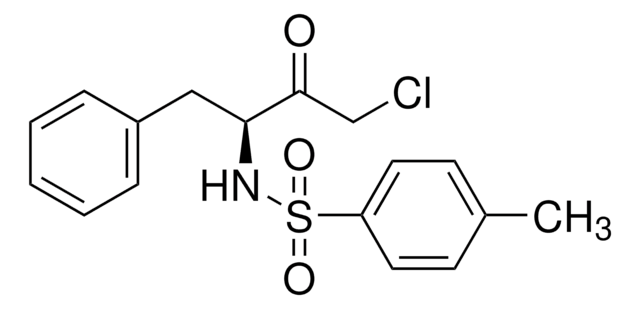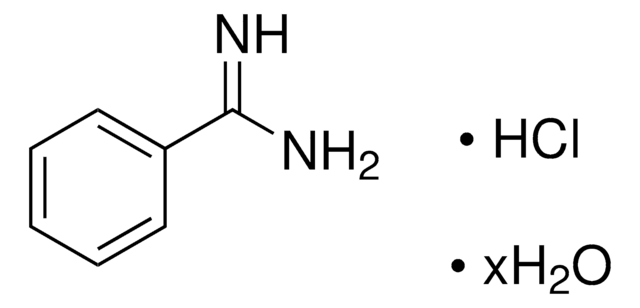52332
Phenylmethylsulfonyl Fluoride
Phenylmethylsulfonyl Fluoride, CAS 329-98-6, is an irreversible inhibitor of serine proteases. It causes sulfonylation of the active-site serine residues.
Synonyme(s) :
Phenylmethylsulfonyl Fluoride, Benzylsulfonyl Fluoride, PMSF
About This Item
Produits recommandés
Niveau de qualité
Pureté
≥99% (GC)
Forme
crystalline solid
Fabricant/nom de marque
Calbiochem®
Conditions de stockage
OK to freeze
desiccated
Couleur
white to off-white
Solubilité
ethanol: soluble
isopropanol: soluble
methanol: soluble
Conditions d'expédition
ambient
Température de stockage
10-30°C
InChI
1S/C7H7FO2S/c8-11(9,10)6-7-4-2-1-3-5-7/h1-5H,6H2
Clé InChI
YBYRMVIVWMBXKQ-UHFFFAOYSA-N
Description générale
Actions biochimiques/physiologiques
serine proteases
Avertissement
Reconstitution
Autres remarques
Weaver, V.M., et al. 1993. Biochem. Cell. Biol.71, 488.
Bourgain, R.H., et al. 1992. Adv. Exp. Med. Biol.316, 427.
Chang, C.T., et al. 1992. Biochem. Int.28, 707.
Informations légales
Mention d'avertissement
Danger
Mentions de danger
Classification des risques
Acute Tox. 3 Oral - Skin Corr. 1B
Code de la classe de stockage
6.1A - Combustible acute toxic Cat. 1 and 2 / very toxic hazardous materials
Classe de danger pour l'eau (WGK)
WGK 3
Point d'éclair (°F)
Not applicable
Point d'éclair (°C)
Not applicable
Certificats d'analyse (COA)
Recherchez un Certificats d'analyse (COA) en saisissant le numéro de lot du produit. Les numéros de lot figurent sur l'étiquette du produit après les mots "Lot" ou "Batch".
Déjà en possession de ce produit ?
Retrouvez la documentation relative aux produits que vous avez récemment achetés dans la Bibliothèque de documents.
Les clients ont également consulté
Notre équipe de scientifiques dispose d'une expérience dans tous les secteurs de la recherche, notamment en sciences de la vie, science des matériaux, synthèse chimique, chromatographie, analyse et dans de nombreux autres domaines..
Contacter notre Service technique














